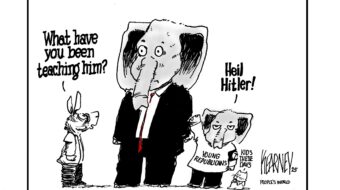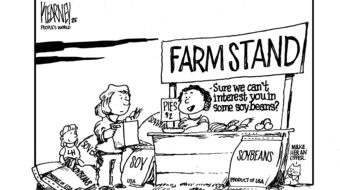WASHINGTON – (PAI) Sometimes it can be fun to get inside someone’s crazy worldview to ask how they deal with contradictory evidence. For example, how do creationists reconcile their view that all plants and animals were created in their current form around 10,000 years ago with fossil evidence of life forms dating back hundreds of millions of years?
In this vein, it’s worth asking how the proponents of deficit-reduction – be they congressional Republicans or “deficit hawks” within the Obama administration – think that lower deficits will lead to increased growth and job creation in an economy mired in a severe slump. There is not an easy answer.
There is a standard Econ 101 story, which these folks preach, about how reducing deficits can boost the economy. The theory goes that if the government reduces its deficit, and therefore borrows less, the lower demand for money will reduce interest rates. Lower interest rates will in turn give firms incentive to invest more.
Lower interest rates should also cause the dollar to decline, since the lower rates will make U.S. government bonds and other dollar assets less attractive to foreign investors. If the dollar falls in value then our goods will be more competitive on world markets. This will cause us to import less and export more, thereby creating jobs.
But this what the deficit hawks believe will happen now? The interest rate on 10-year Treasury bonds is already down to 3.0 percent. Assuming a 2 percent inflation rate, this translates into a real interest rate of about 1 percent.
How much lower do the deficit hawks think interest rates will fall if we were to sharply cut the deficit? Furthermore, how much more investment do they think we can induce even if we got a large (e.g. 0.5 percent) reduction in real interest rates?
Do they think this sort of decline in interest rates will send the dollar tumbling and thereby improve our trade balance? Against which currencies will a lower interest rate cause the dollar to fall sharply?
Neither of these stories really passes the laugh test. At best we may hope to see modestly lower interest rates if cutting the budget deficit slows growth further. But there is no reason to expect any future decline to have any more impact than the recent decline in the 10-year Treasury rate from 3.6 percent last winter to near 3.0 percent now.
The deficit hawks push another story: If we lay off workers in the public sector, employment will increase in the private sector.
The story here is presumably that mass layoffs of public sector workers will depress the wages of workers further, thereby making it more profitable for employers to hire them.
There’s a simple problem in this picture: For wages to actually fall, additional private sector employment must not be as large as the job loss in the public sector.
In other words, if we lay off 500,000 public sector workers, then the private sector must increase employment by less than 500,000 workers, otherwise wages would rise, not fall, and businesses would then not have any incentive to hire more workers.
This means that this route of economic stimulus through government cutbacks can at best get us close to where we were before the layoffs. It is not a way to add jobs to the economy. And even in a best-case scenario it would take a considerable period of time to get close, since wages do not fall quickly.
Neither of these channels sounds very promising. This leaves the mystery channel of “bad feelings.” This story goes that businesses feel bad about the deficit. They are worried they might pay higher taxes in the future, there could be inflation, or the government could collapse. Therefore, businesses that would otherwise be investing their hefty profits are instead sitting on them.
There are two problems with the bad feelings story. First, businesses actually are investing at a pretty healthy rate, just not in areas that create jobs. There was huge overbuilding of structures in the real estate boom, but investment in equipment and software as a share of GDP is almost back to its pre-recession level.
Given the excess capacity in this sector, we really should be asking why investment is so high, not why it is low.
The second problem with this story is that the fear of higher taxes in the future is a good reason for businesses to try to invest and earn profits now. When the Congressional Budget Office used various models to examine the impact of Bush-type tax cuts, the ones that showed the most positive effects were ones that assumed the tax cuts would be temporary.
This effectively pulled investment and work effort forward into the low tax period. The point is that if people really believed they would pay much higher taxes in the future, then they should be working hard and investing today, the opposite of the deficit hawk story.
So at the end of the day, we don’t have a coherent story on how reducing the budget deficit will boost growth just as the creationists don’t have a coherent explanation for what we know about the plant and animal kingdoms. The big difference is that the deficit hawks are determining economic policy.
Dean Baker is the co-director of the Center for Economic and Policy Research, a Washington think tank. He is the author of “False Profits: Recovering from the Bubble Economy.”










